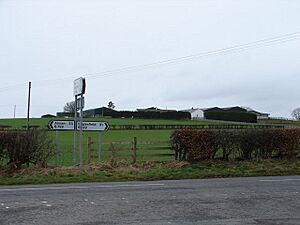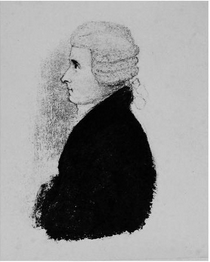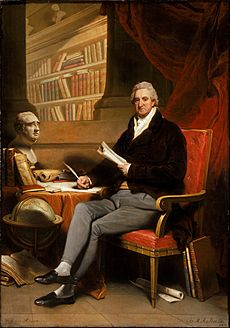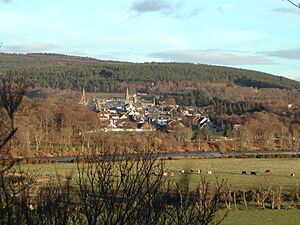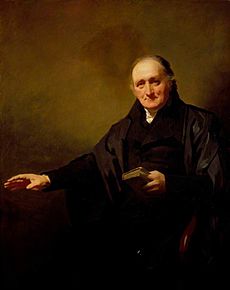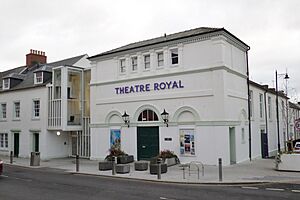William Nicol (teacher) facts for kids
Quick facts for kids
William Nicol
|
|
|---|---|

Glencairn Parish Church at Kirkland.
|
|
| Born | 1744 Annan parish
|
| Died | 21 April 1797 Edinburgh
|
| Occupation | Teacher |
William Nicol (1744–1797) was a Scottish schoolmaster. He was a close friend of the famous poet Robert Burns. Nicol was born in the Annan parish at Dumbretton, Dumfries and Galloway, Scotland.
Robert Burns once called him "Kind hearted Willie". Nicol joined Burns on a trip through the Highlands in August 1787. Burns's third son, William Nicol, born in 1791, was named after his friend. Burns even joked that his newborn son already showed signs of being clever and a bit mischievous.
Contents
William Nicol's Life and Work
William Nicol's father was a tailor who passed away when Nicol was very young. Nicol later married Janet Cairns. They bought a large piece of land called Lagganpark in Glencairns parish. This was in 1790.
Burns was too unwell to visit the property himself. So, he sent two friends to check it out. They advised Nicol to buy it, which he did. Burns later visited Lagganpark. He even found valuable limestone deposits on the land.
Nicol likely bought Lagganpark as an investment for his retirement. He planned to rent it out. However, Nicol became ill. He sold the estate just a few days before he passed away in April 1797.
Becoming a Teacher
Nicol first learned from a traveling teacher. As a teenager, he started his own small school at his mother's house. He then attended Annan Academy. Later, he studied at Edinburgh University. He studied Theology, then Medicine, and finally Classics.
In 1774, at age 30, Nicol became a Classics teacher at the High School in Edinburgh. He was known as an excellent scholar. However, he was also a very strict teacher. Lord Cockburn, a famous writer, said Nicol was "very hurtful to all his pupils" because of his constant harshness. But another lawyer, Alexander Young, thought Nicol was "one of the greatest Latin scholars of the age."
In 1795, Nicol left the High School. He started his own school. He ran it successfully for two years until his death in 1797. He is believed to be buried in the Old Carlton Burying Ground.
Working with Latin
Nicol often helped students at Edinburgh University. He would translate their medical law papers into Latin for a small fee. However, he sometimes had trouble getting paid. He even hired a lawyer, Alexander Young, to help him collect money from people who owed him.
Nicol was also a member of a group called Canongate Kilwinning Lodge No.2. However, his strong personality meant he was not always popular in Edinburgh.
William Nicol and Robert Burns
It is not clear how William Nicol and Robert Burns first met. They became friends in 1787. Nicol joined Burns on his tour of the Highlands that August. The trip was mostly paid for by Burns. Nicol's strong personality sometimes made the journey difficult.
The Stirling Incident
While in Stirling, after seeing the castle, Burns wrote some lines on a window pane at an inn. These lines were about the history of Scotland's kings. Some people have suggested that Nicol, who had strong beliefs about Scottish history, might have written them.
A Trip to Gordon Castle
A famous story tells of Nicol getting upset when Burns was invited to dinner. The invitation was from the Duke and Duchess of Gordon. Burns had left Nicol at the inn in Fochabers. Nicol felt left out. He packed his bags and was ready to leave. Burns had to return to get him. Because of this, Burns felt he had to turn down the invitation.
Burns later joked that traveling with Nicol was "Like travelling with a loaded blunderbuss at full cock." This meant it was unpredictable and a bit dangerous.
Friendship and Poems
Nicol introduced Burns to another friend, William Cruikshank. Cruikshank was also a Classics teacher.
Dowie's Tavern in Edinburgh was a favorite spot for Burns, Nicol, and their friend Allan Masterton. They were all part of a club called the Crochallan Fencibles. Many other artists and writers also visited Dowie's.
One time, Burns, Nicol, and Masterton were at The Globe Tavern in Dumfries. Burns had forgotten to order food. So, they ate a sheep's head that was meant for the landlord. Nicol is said to have encouraged Burns to write a "Grace Before and After Meat" as a thank you.
Burns also wrote an "Epitaph for William Nicol" and an "Elegy on Willie Nicol's Mare." Burns had borrowed a horse named Peg Nicholson from Nicol. The horse, which had been through a lot before Nicol owned her, sadly died while Burns had her. This caused Burns some trouble and expense.
The poem "Willie Brewed a Peck o'Maut" was written by Burns. The music was by Masterton. It was inspired by a fun time they had near Moffat with Nicol.
When Burns died, John Lewars wrote to inform Nicol. Nicol was very sad. He wrote about "the premature death of my dearly beloved Burns" and how he could no longer enjoy nature or social gatherings in the same way.
Letters Between Friends
Burns wrote a letter to "Kind hearted Willie" in pure Scottish language on June 1, 1787.
In June 1787, Burns wrote to Nicol from Ellisland Farm. He mentioned a local minister and his wife, Anne, saying how much he admired her.
Burns also wrote to Nicol about his second son, Francis Wallace.
After returning home from Edinburgh, Burns wrote to Nicol about how some people who used to look down on him were now being overly polite.
In February 1790, Burns wrote to Nicol with excitement. He talked about a successful theater company in Dumfries. He also mentioned plans to build a new theater there.
Burns wrote to Nicol, expressing his deep admiration: "O Mr Nicol, can I ever extinguish the glowing remembrance of you in my bosom!" He praised Nicol's abilities and kindness.
In August 1790, Nicol wrote to Robert Ainslie. He joked about Burns's ambition to get a promotion in his job as an Excise officer. Nicol also advised Burns to be careful about expressing his political views. Burns replied with a humorous letter.
Nicol also wrote to Burns when he was worried about a situation at the Dumfries theater. Burns was almost in danger of losing his job. Nicol wrote, "Dear Christless Bobbie, What has become of thee?" showing his concern for his friend.
In May 1795, Burns wrote to George Thomson. He commented on a drawing of him by an artist named David Allan. Burns said he named a small boy in the drawing, who was chasing a cat, "Willie Nocol" after his schoolmaster friend.
Burns also copied one of his letters to Nicol into his important collection of writings called the Glenriddell Manuscripts.
|
See also
- Robert Aiken
- Jean Armour
- Lesley Baillie
- John Ballantine
- Alison Begbie
- Nelly Blair
- Isabella Burns
- May Cameron
- Mary Campbell (Highland Mary)
- Jenny Clow
- Gavin Hamilton (lawyer)
- Helen Hyslop
- Nelly Kilpatrick
- Jessie Lewars
- Anne Rankine
- Isabella Steven
- Peggy Thompson
- James Smith (draper)
- John Murdoch (teacher)


